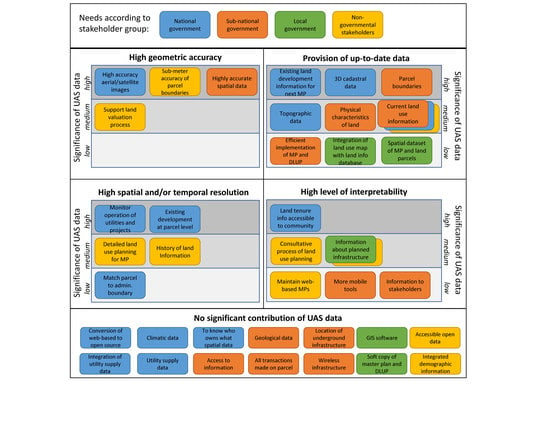Unmanned Aerial System Imagery, Land Data and User Needs: A Socio-Technical Assessment in Rwanda
Abstract
:1. Introduction
2. Study Area
3. Material and Methods
3.1. Needs Assessment
3.2. UAS Data Collection
3.2.1. UAS Regulations in Rwanda
3.2.2. UAS Equipment
3.2.3. Ground Control Measurements
3.2.4. Software and Hardware Requirements
4. Results
4.1. What Land Information do Rwandan Stakeholders Need?
4.1.1. Government Stakeholders’ Needs
4.1.2. Local Government and Communities’ Needs
4.1.3. Non-Government Stakeholders’ Needs
4.2. What Data Quality can be Achieved with UAS-Technology?
4.3. Can UAS Respond to the Needs Expressed by Different Stakeholders?
4.3.1. High Geometric Accuracy
4.3.2. Provision of up-to-Date Data
4.3.3. High Spatial and/or Temporal Resolution
4.3.4. High Level of Interpretability
5. Discussion
5.1. Opportunities of UAS Data Collection to Match Land Information Needs
5.2. Challenges of UAS Data Collection to Match Land Information Needs
5.3. Limitations of this Research and Future Work
6. Conclusions
Author Contributions
Funding
Acknowledgments
Conflicts of Interest
References
- Colomina, I.; Molina, P. Unmanned aerial systems for photogrammetry and remote sensing: A review. ISPRS J. Photogramm. Remote Sens. 2014, 92, 79–97. [Google Scholar] [CrossRef] [Green Version]
- Nex, F.; Remondino, F. UAV for 3D mapping applications: A review. Appl. Geomat. 2014, 6, 1–15. [Google Scholar] [CrossRef]
- Mesas-Carrascosa, F.J.; Notario-García, M.D.; de Larriva, M.D.N.G.; de la Orden, M.S.; Porras, A.G.F. Validation of measurements of land plot area using UAV imagery. Int. J. Appl. Earth Obs. Geoinf. 2014, 33, 270–279. [Google Scholar] [CrossRef]
- Honkavaara, E.; Kaivosoja, J.; Mäkynen, J.; Pellikka, I.; Pesonen, L.; Saari, H.; Salo, H.; Hakala, T.; Marklelin, L.; Rosnell, T. Hyperspectral Reflectance Signatures and Point Clouds for Precision Agriculture By Light Weight Uav Imaging System. Ann. Photogramm. Remote Sens. Spat. Inf. Sci. 2012, I-7, 353–358. [Google Scholar] [CrossRef]
- De Castro, A.I.; Torres-Sánchez, J.; Peña, J.M.; Jiménez-Brenes, F.M.; Csillik, O.; López-Granados, F. An automatic random forest-OBIA algorithm for early weed mapping between and within crop rows using UAV imagery. Remote Sens. 2018, 10, 285. [Google Scholar] [CrossRef]
- Eltner, A.; Kaiser, A.; Castillo, C.; Rock, G.; Neugirg, F.; Abellan, A. Image-based surface reconstruction in geomorphometry—Merits, limits and developments of a promising tool for geoscientists. Earth Surf. Dyn. Discuss. 2015, 1445–1508. [Google Scholar] [CrossRef]
- James, M.R.; Robson, S.; d’Oleire-Oltmanns, S.; Niethammer, U. Optimising UAV topographic surveys processed with structure-from-motion: Ground control quality, quantity and bundle adjustment. Geomorphology 2017, 280, 51–66. [Google Scholar] [CrossRef]
- Bemis, S.P.; Micklethwaite, S.; Turner, D.; James, M.R.; Akciz, S.; Thiele, S.T.; Bangash, H.A. Ground-based and UAV-Based photogrammetry: A multi-scale, high-resolution mapping tool for structural geology and paleoseismology. J. Struct. Geol. 2014, 69, 162–178. [Google Scholar] [CrossRef]
- Nikolakopoulos, K.G.; Kozarski, D.; Kogkas, S. Coastal areas mapping using UAV photogrammetry. Proc. SPIE 2017, 10428, 104280O. [Google Scholar]
- Szantoi, Z.; Smith, S.E.; Strona, G.; Koh, L.P.; Wich, S.A. Mapping orangutan habitat and agricultural areas using Landsat OLI imagery augmented with unmanned aircraft system aerial photography. Int. J. Remote Sens. 2017, 38, 2231–2245. [Google Scholar] [CrossRef] [Green Version]
- Adams, S.M.; Friedland, C.J. A Survey of Unmanned Aerial Vehicle (UAV) Usage for Imagery Collection in Disaster Research and Management. In Proceedings of the 9th International Workshop on Remote Sensing for Disaster Response, Stanfort University, Stanford, CA, USA, 15–16 September 2011. [Google Scholar]
- Erdelj, M.; Natalizio, E.; Chowdhury, K.R.; Akyildiz, I.F. Help from the Sky: Leveraging UAVs for Disaster Management. IEEE Pervasive Comput. 2017, 16, 24–32. [Google Scholar] [CrossRef]
- Pajares, G. Overview and Current Status of Remote Sensing Applications Based on Unmanned Aerial Vehicles (UAVs). Photogramm. Eng. Remote Sens. 2015, 81, 281–330. [Google Scholar] [CrossRef]
- Stöcker, C.; Bennett, R.; Nex, F.; Gerke, M.; Zevenbergen, J. Review of the current state of UAV regulations. Remote Sens. 2017, 9, 459. [Google Scholar] [CrossRef]
- Manyoky, M.; Theiler, P.; Steudler, D.; Eisenbeiss, H. Unmanned Aerial Vehicle in Cadastral Applications. ISPRS Int. Arch. Photogramm. Remote Sens. Spat. Inf. Sci. 2012, XXXVIII-1, 57–62. [Google Scholar] [CrossRef]
- Rijsdijk, M.; Van Hinsbergh, W.H.M.; Witteveen, W.; Buuren, G.H.M.; Schakelaar, G.A.; Poppinga, G.; Van Persie, M.; Ladiges, R. Unmanned Aerial Systems in the Process of Juridical Verification of Cadastral Border. Int. Arch. Photogramm. Remote Sens. 2013, XL, 4–6. [Google Scholar] [CrossRef]
- Barnes, G.; Volkmann, W. High-Resolution Mapping with Unmanned Aerial Systems. Surv. Land Inf. Sci. 2015, 74, 5–13. [Google Scholar]
- Mumbone, M.; Bennett, R.M.; Gerke, M.; Volkmann, W. Innovations in boundary mapping: Namibia, customary lands and UAVs. Proceedigs of the 16th Annual World Bank Conference on Land and Poverty 2015: Linking Land Tenure and Use for Shared Prosperity, Washington, DC, USA, 23–27 March 2015; Volume 1. [Google Scholar]
- Ramadhani, S.A.; Bennett, R.M.; Nex, F.C. Exploring UAV in Indonesian cadastral boundary data acquisition. Earth Sci. Inform. 2018, 11, 129–146. [Google Scholar] [CrossRef]
- Stöcker, C.; Koeva, M.; Bennett, R.; Zevenbergen, J. Evaluation of UAV-based technology to capture land rights in Kenya: Displaying stakeholder perspectives through interactive gaming. In Proceedings of the 20th Annual World Bank Conference on Land and Poverty 2019: Catalyzing Innovation, Washington, DC, USA, 25–29 March 2019. [Google Scholar]
- Enemark, S.; Bell, K.C.; Lemmen, C.; McLaren, R. Fit-For-Purpose Land Administration; World Bank and International Federation of Surveyors: Washington, DC, USA, 2014; ISBN 9788792853103. [Google Scholar]
- Zevenbergen, J.; De Vries, W.T.; Bennett, R.M. Advances in Responsible Land Administration; CRC Press: Boca Raton, FL, USA, 2015. [Google Scholar]
- Zevenbergen, J.; Augustinus, C.; Antonio, D.; Bennett, R. Pro-poor land administration: Principles for recording the land rights of the underrepresented. Land Use Policy 2013, 31, 595–604. [Google Scholar] [CrossRef]
- Ottens, M.; Stubkjær, E. A socio-technical analysis of cadastral systems. In Real Property Transactions; Zevenbergen, J., Frank, A., Stubkjær, E., Eds.; IOS Press: Clifton, VA, USA, 2007; p. 143. ISBN 9781586035815. [Google Scholar]
- Fourth Population and Housing Census, 2012 Census Atlas; National Institute of Statistics Rwanda (NISR): Kigali, Rwanda, 2014.
- Rwanda National Human Development Report 2014 (March 2015); UNDP and Government of Rwanda 2015: New York, NY, USA, 2015.
- Gillingham, P.; Buckle, F. Rwanda Land Tenure Regularisation Case Study; HTSPE Limited for Evidence on Demand and UK Department for International Development (DFID): Hertfordshire, UK, 2014.
- Ngoga, T.H. Rwanda’s Land Tenure Reform; CABI: Wallingford, UK, 2018. [Google Scholar]
- Rosen, J. MIT Technology Review. 2017. [Google Scholar]
- Delbecq, A.L.; Van de Ven, A.H.; Gustafson, D.H. Group Techniques for Program Planning: A Guide to Nominal Group and Delphi Processes; Green Briar Press: Denver, OR, USA, 1975; ISBN 9780673075918. [Google Scholar]
- Sink, D.S. Using the nominal group technique effectively. Natl. Product. Rev. 1983, 2, 173–184. [Google Scholar] [CrossRef]
- Witkin, B.R.; Altschuld, J.W. Planning and Conducting Needs Assessments: A Practical Guide; SAGE Publications Inc.: Thousand Oaks, CA, USA, 1995. [Google Scholar]
- World Bank Needs Assess. Knowl. Base; World Bank Institute Evaluation Group Nominal Group Technique: Washington, DC, USA, 2007.
- Delbecq, A.L.; Van de Ven, A.H. A group process model for problem identification and program planning. J. Appl. Behav. Sci. 1971, 7, 466–492. [Google Scholar] [CrossRef]
- Langford, B.E.; Schoenfeld, G.; Izzo, G. Nominal grouping sessions vs focus groups. Qual. Mark. Res. Int. J. 2002, 5, 58–70. [Google Scholar] [CrossRef]
- Lloyd, S. Applying the nominal group technique to specify the domain of a construct. Qual. Mark. Res. Int. J. 2011, 14, 105–121. [Google Scholar] [CrossRef]
- Cantrill, J.A.; Sibbald, B.; Buetow, S. The Delphi and nominal group techniques in health services research The Delphi technique. Int. J. Pharm. Pract. 1996, 4, 67–74. [Google Scholar] [CrossRef]
- RCAA Ministerial Regulations No 01/MOS/Trans/016 of 26/04/2016 Relating to Unmanned Civil Aircraft System; Rwanda Civil Aviation Authority: Kigali, Rwanda, 2016.
- Stöcker, C.; Ho, S.; Bennett, R.; Koeva, M.; Schmidt, C.; Nkerabigwi, P.; Zevenbergen, J. Towards UAV-based Land Tenure Data Acquisition in Rwanda: Needs Assessment and Technology Response. In Proceedings of the XXVI FIG Congress 2018: Embracing Our Smart World Where the Continents Connect: Enhancing the Geospatial Maturity of Societies, Istanbul, Turkey, 6–11 May 2018. [Google Scholar]
- RCAA Ministerial Regulations No 01/MOS/Trans/2018 of 23/01/2018 Relating to Unmanned Civil Aircraft System; Rwanda Civil Aviation Authority: Kigali, Rwanda, 2018.
- Stöcker, C.; Nex, F.; Koeva, M.; Gerke, M. Quality assessment of combined IMU/GNSS data for direct georeferencing in the context of UAV-based mapping. In Proceedings of the ISPRS 2017: International Conference on Unmanned Aerial Vehicles in Geomatics, Bonn, Germany, 4–7 September 2017; Volume 42. [Google Scholar]
- Remondino, F.; Barazzetti, L.; Nex, F.; Scaioni, M.; Sarazzi, D. Uav Photogrammetry for Mapping and 3D Modeling—Current Status and Future Perspectives. Int. Arch. Photogramm. 2011, XXXVIII, 14–16. [Google Scholar] [CrossRef]
- Benassi, F.; Dall’Asta, E.; Diotri, F.; Forlani, G.; di Cella, U.M.; Roncella, R.; Santise, M. Testing accuracy and repeatability of UAV blocks oriented with gnss-supported aerial triangulation. Remote Sens. 2017, 9, 172. [Google Scholar] [CrossRef]
- Gerke, M.; Przybilla, H.J. Accuracy Analysis of Photogrammetric UAV Image Blocks: Influence of Onboard RTK-GNSS and Cross Flight Patterns. Photogramm. Fernerkundung Geoinf. 2016, 17–30. [Google Scholar] [CrossRef]
- Agüera-Vega, F.; Carvajal-Ramírez, F.; Martínez-Carricondo, P. Assessment of photogrammetric mapping accuracy based on variation ground control points number using unmanned aerial vehicle. Meas. J. Int. Meas. Confed. 2017, 98, 221–227. [Google Scholar] [CrossRef]
- Enemark, S.; McLaren, R.; Lemmen, C.; Antonio, D.; Gitau, J. Guiding principles for building fit-for-purpose land administration systems in developing countries. In Proceedings of the Land and Poverty Conference 2016: Scaling up Responsible Land Governance, Washington, DC, USA, 14–18 March 2016. [Google Scholar]
- Widodo, S.; Safik, A.; Chaerani, M.; Pramudhiarta, N.; Hardiono, M.; Feld, S.; Barthel, K.; Rolfes, L.; Biringkanae, N.; Sugiri, A. Empowering Communities to Mark Boundaries and Map Resources with Geospatial Technology: Early Results of using UAVs in Participatory Village Boundary Setting/Resource Mapping (VBS/RM) activity in Indonesia. In Proceedings of the Land and Poverty Conference 2016: Scaling up Responsible Land Governance, Washington, DC, USA, 14–18 March 2016. [Google Scholar]
- NEPAD Drones on the Horizon—Transforming African’s Horizon; Union African: Addis Ababa, Ethiopia, 2018.
- Enemark, S. Building Land Information Policies. In Proceedings of the Special Forum on Building Land Information Policies in the Americas, Aguascalientes, Mexico, 26–27 October 2004. [Google Scholar]
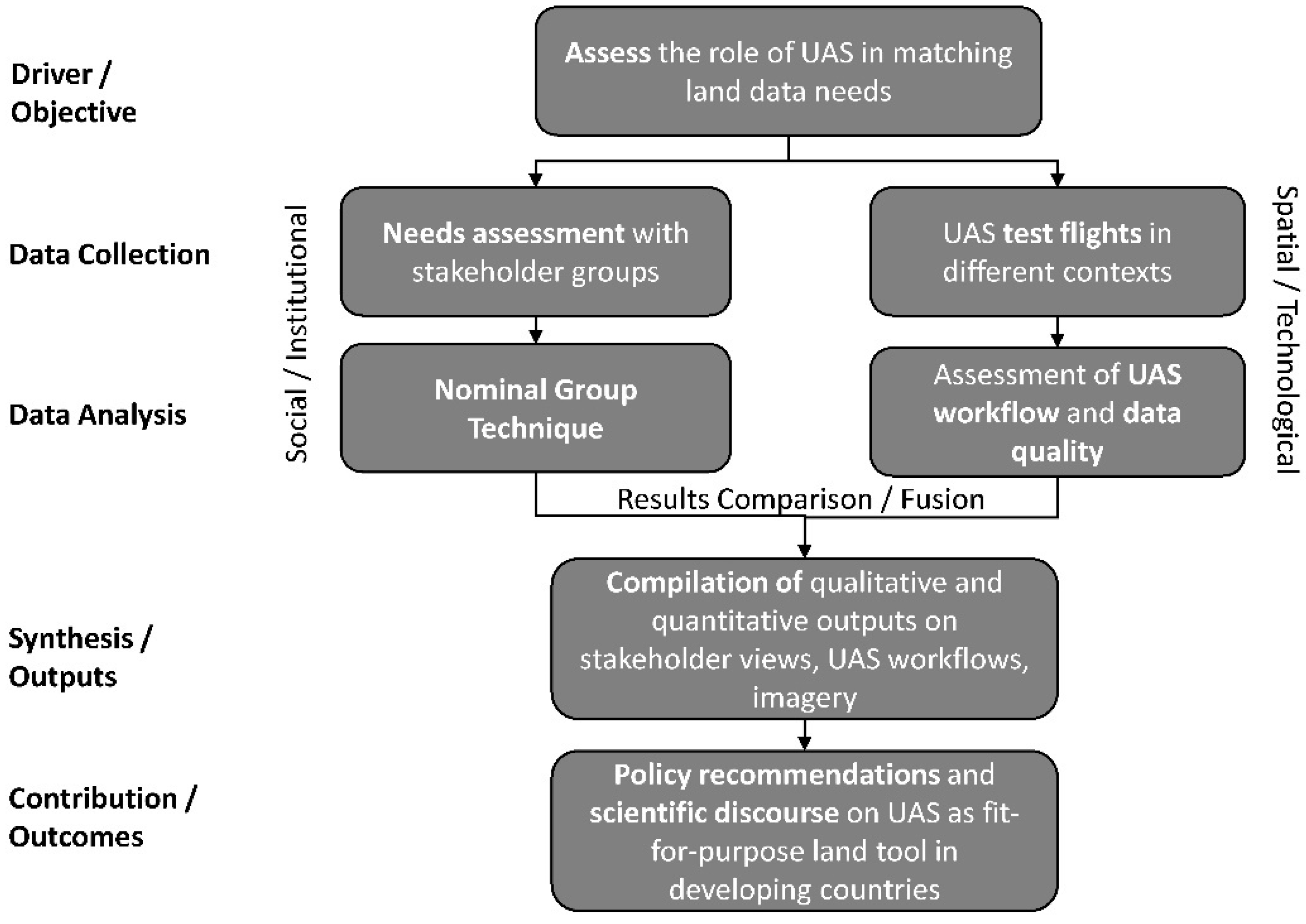

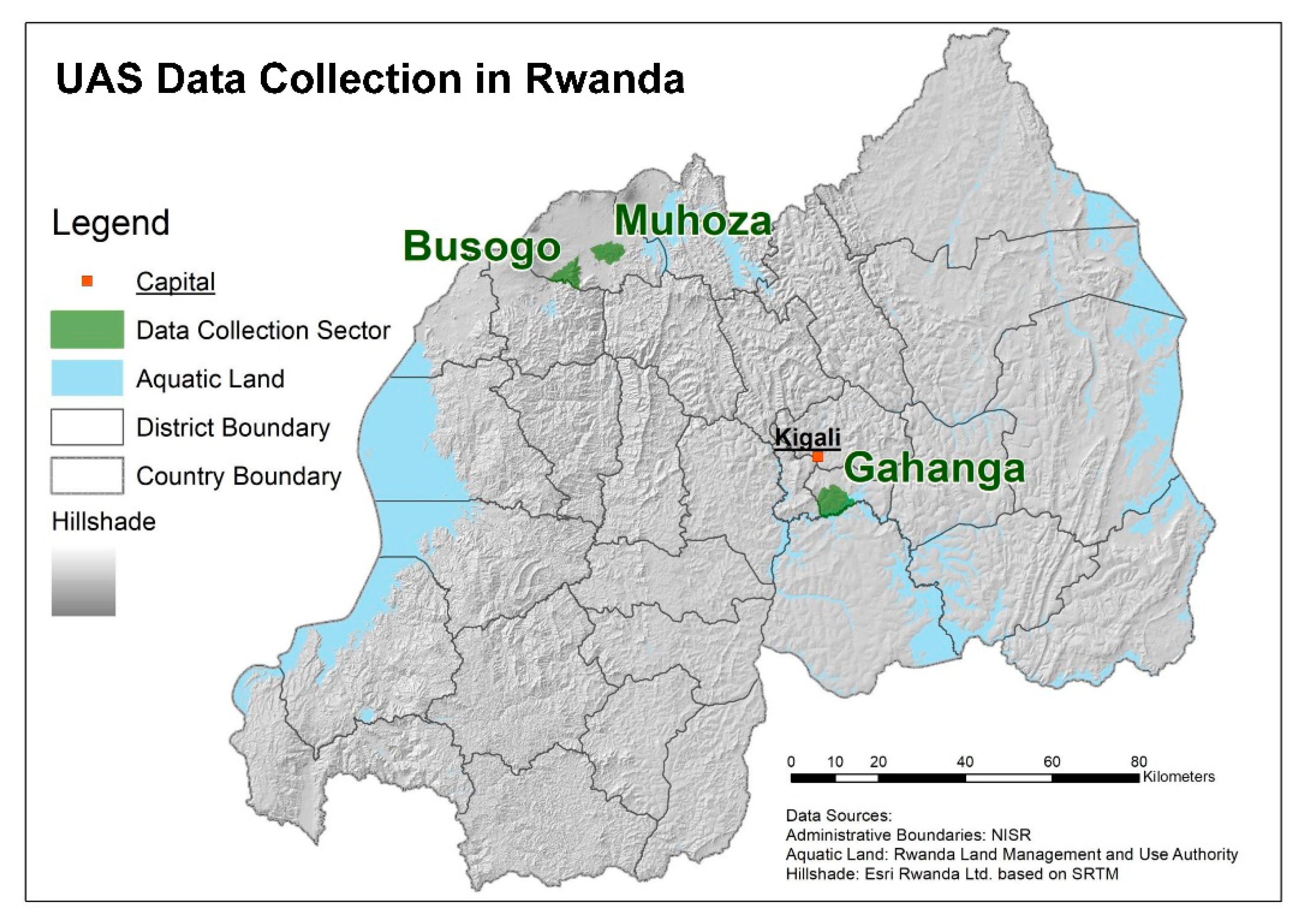
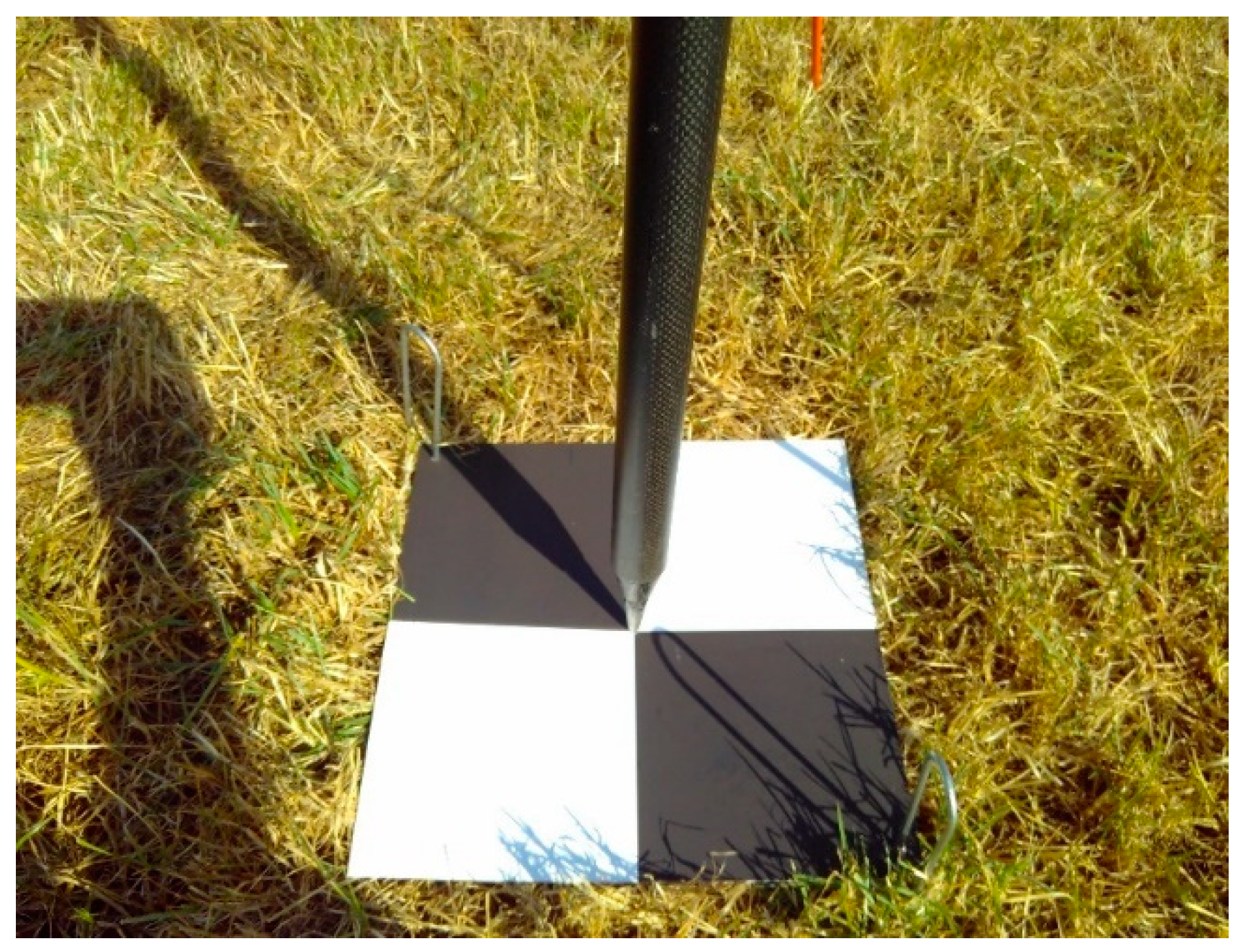
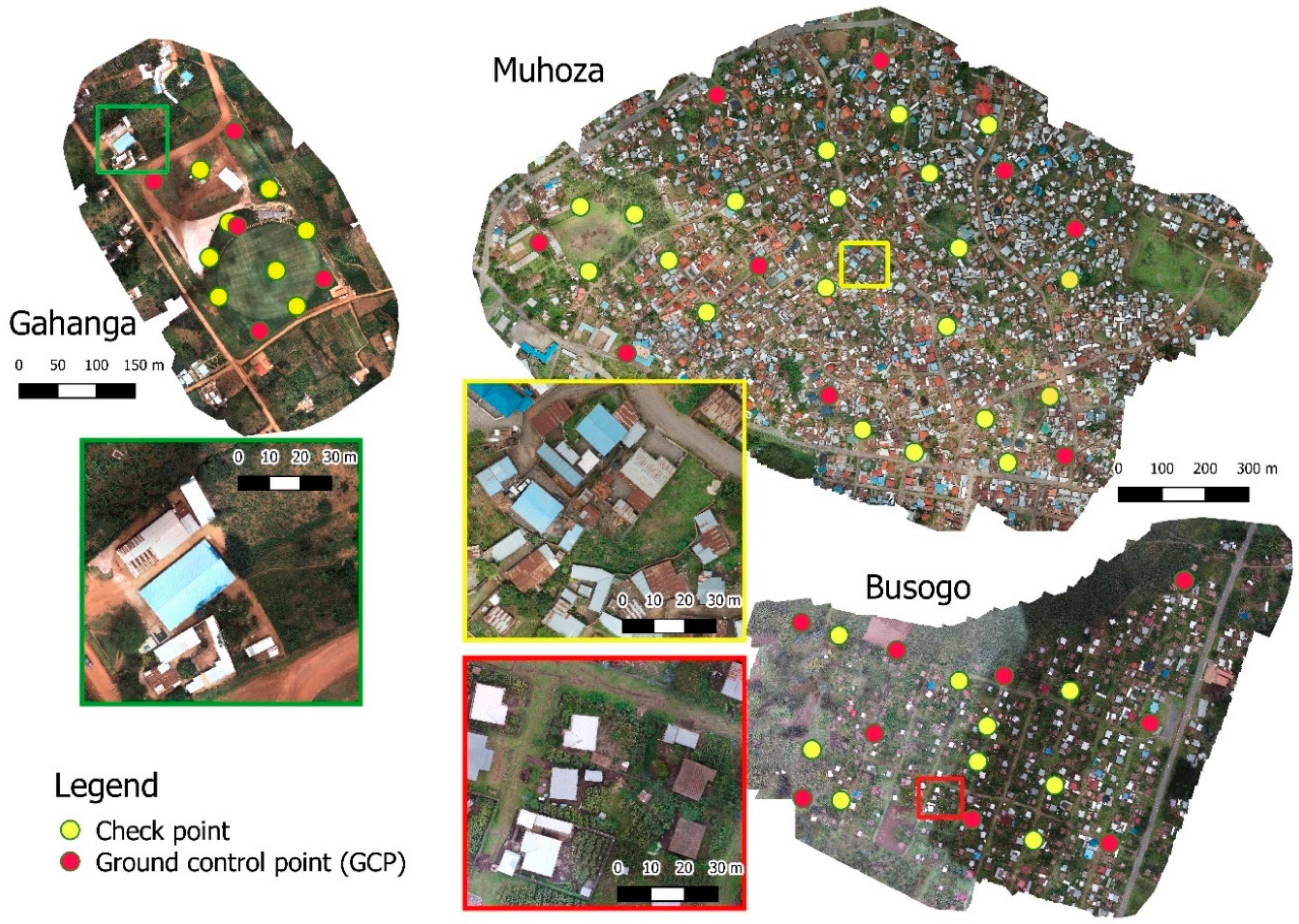
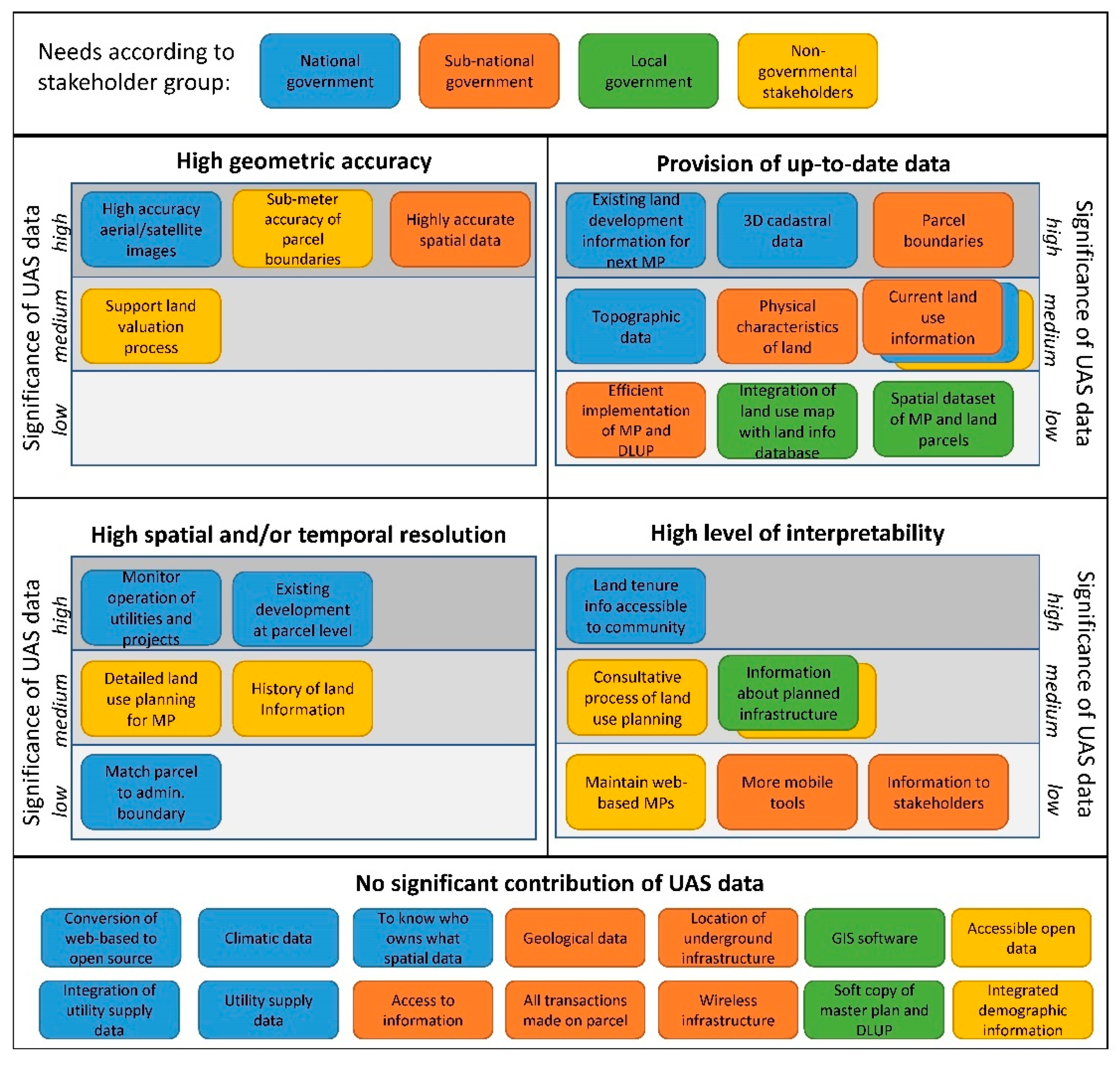

| Stakeholder Class | Organisations | |
|---|---|---|
| Contacted | Participated | |
| Public sector organizations specific to land administration (national, province, district, sector, cell levels) | 12 | 12 |
| Public sector organizations (adjacent domains to land) | 12 | 3 |
| Non-statutory organizations | 1 | 1 |
| Private sector organizations | 3 | 3 |
| NGOs, Not-for-profit/Donors and Development partners; | 6 | 0 |
| Research & Development (R&D) | 4 | 3 |
| Operational Limitation | Specification |
|---|---|
| Maximum take-off weight | 25 kg |
| Time for UAS operation | Only daylight operation |
| Minimum distance to aerodrome | 10 km |
| Maximum flight height | 100 m (increased to 120 m in 2018) |
| Visual Line Of Sight | Required but undefined |
| Maximum lateral distance pilot to UAS | 300 m (abolished in 2018) |
| Minimum lateral distance to people, vessels, animals, building and structures | 30 m (increased to 100 m in 2018) |
| Restricted areas | Congested areas of cities, towns or settlements |
| Ethics and privacy | Respect privacy of oth ers, surveillance of peo ple and property with out their consent is pro hibited |
| Name | Inspire 2 (DJI) | FireFLY6 (BIRDSEYEVIEW) | DT18 PPK (Delair Tech) |
|---|---|---|---|
 |  |  | |
| Type | Rotary wing UAS | Hybrid UAS | Fixed-wing UAS |
| Sensor | Zenmuse X5S | SONY A6000 | DT18 3Bands PPK |
| Sensor size | 13 x 17.3 mm | 23.5 x 15.6 mm | 8.45 x 7.07 mm |
| Pixel pitch | 2.48 µm | 3.92 µm | 3.45 µm |
| Sensor resolution | 5280 x 3956 (20.1MP) | 6000 x 4000 (24 MP) | 2448 x 2048 (5MP) |
| Area | Busogo (50 ha)–3 flights | Muhoza (94 ha)–2 flights | Gahanga (14 ha)–1 flight |
| Data collection | 497 nadir images (total flight time: 45 min) | 991 nadir images (total flight time: 60 min) | 372 nadir images (total flight time: 20 min) |
| Main features | Versality Requires only small space for landing | Flight stability Requires only small space for landing Long endurance | Long flight endurance PPK-capable Automatic flight and landing mode |
| Dataset | Block Orientation Method | GNSS Device for Ground Truthing Measurements | Count GCPs | Count Checkpoints |
|---|---|---|---|---|
| Muhoza | GNSS-supported Aerial Triangulation (GNSS-AT) | Leica CS10 and Trimble GeoXH | 9 | 20 |
| Busogo | GNSS-supported Aerial Triangulation (GNSS-AT) | Leica CS10 | 9 | 9 |
| Gahanga | Integrated Sensor Orientation | Trimble GeoXH | 5 | 8 |
| Area | Teams Deployed | Reference Points Measured Pre-Flight | Reference Points Remained Post-Flight | Time between Measurement and Final Collection of Ground Marker |
|---|---|---|---|---|
| Muhoza | 2 | 39 | 30 | 5 h |
| Busogo | 1 | 22 | 18 | 3 h |
| Gahanga | 1 | 13 | 13 | 2 h |
| National Level Government | Relative Importance | Popularity |
|---|---|---|
| High accuracy satellite/aerial imagery | 18.7 | 0.8 |
| To know who owns what spatial data | 14.7 | 0.8 |
| Current land use information | 9.3 | 0.4 |
| 3D cadastral data | 8.0 | 0.4 |
| Utility supply data | 6.7 | 0.6 |
| Convert existing web-based system to opensource | 6.7 | 0.2 |
| Match land parcel to admin boundary | 6.7 | 0.2 |
| Monitor operation of utilities and projects | 6.7 | 0.4 |
| Integration of utility supply data | 6.7 | 0.4 |
| Existing development at parcel level | 4.0 | 0.2 |
| Sub-national level Government (District) | ||
| Highly accurate spatial data (incl. imagery) | 29.63 | 1.00 |
| More mobile tools | 11.85 | 0.56 |
| Physical characteristics of land | 11.85 | 0.44 |
| Access to information | 10.37 | 0.56 |
| Geological data | 8.15 | 0.33 |
| Land use | 5.93 | 0.56 |
| Implementation of masterplan and DLUP in an efficient way | 4.44 | 0.22 |
| Parcel boundaries | 2.96 | 0.22 |
| Location of underground infrastructure | 2.96 | 0.22 |
| All transactions made on parcel | 1.48 | 0.11 |
| Information to stakeholders | 0.74 | 0.11 |
| Wireless infrastructure | 0.74 | 0.11 |
| Local level Government (Cell) | ||
| Spatial dataset of master plan and land parcels | 0.67 | |
| GIS software | 0.67 | |
| Soft copy of master plan | 0.5 | |
| Soft copy of the DLUP | 0.33 | |
| Integration of land use map with land information database | 0.33 | |
| Information about planned infrastructure | 0.17 |
| Non-Government | Relative Importance | Popularity |
|---|---|---|
| Value of land (valuation process) | 22.67 | 0.8 |
| Accessible open data | 18.67 | 0.6 |
| Consultative process around land use planning | 12.00 | 0.4 |
| More detailed (sub-use) land use planning in Master Plan | 10.67 | 0.6 |
| Actual land use information | 9.33 | 0.6 |
| History of land Information to resolve conflict between infrastructure development and arable land | 9.33 | 0.6 |
| Integrated demographic information | 6.67 | 0.6 |
| Sub-meter accuracy of parcel boundaries (urban/peri-urban) | 6.67 | 0.4 |
| Information about proposed infrastructure development and potential risks | 4.00 | 0.4 |
| Maintained web-based Master Plans | 2.67 | 0.2 |
| Area | Ground Sampling Distance | RMS Error of CP Residuals (X/Y/Z) |
|---|---|---|
| Muhoza | 2.16 cm | 0.122m/0.086m/0.467m |
| Busogo | 2.18 cm | 0.033m/0.031m/0.349m |
| Gahanga | 2.63 cm | 0.127m/0.170m/0.244m |
© 2019 by the authors. Licensee MDPI, Basel, Switzerland. This article is an open access article distributed under the terms and conditions of the Creative Commons Attribution (CC BY) license (http://creativecommons.org/licenses/by/4.0/).
Share and Cite
Stöcker, C.; Ho, S.; Nkerabigwi, P.; Schmidt, C.; Koeva, M.; Bennett, R.; Zevenbergen, J. Unmanned Aerial System Imagery, Land Data and User Needs: A Socio-Technical Assessment in Rwanda. Remote Sens. 2019, 11, 1035. https://doi.org/10.3390/rs11091035
Stöcker C, Ho S, Nkerabigwi P, Schmidt C, Koeva M, Bennett R, Zevenbergen J. Unmanned Aerial System Imagery, Land Data and User Needs: A Socio-Technical Assessment in Rwanda. Remote Sensing. 2019; 11(9):1035. https://doi.org/10.3390/rs11091035
Chicago/Turabian StyleStöcker, Claudia, Serene Ho, Placide Nkerabigwi, Cornelia Schmidt, Mila Koeva, Rohan Bennett, and Jaap Zevenbergen. 2019. "Unmanned Aerial System Imagery, Land Data and User Needs: A Socio-Technical Assessment in Rwanda" Remote Sensing 11, no. 9: 1035. https://doi.org/10.3390/rs11091035
APA StyleStöcker, C., Ho, S., Nkerabigwi, P., Schmidt, C., Koeva, M., Bennett, R., & Zevenbergen, J. (2019). Unmanned Aerial System Imagery, Land Data and User Needs: A Socio-Technical Assessment in Rwanda. Remote Sensing, 11(9), 1035. https://doi.org/10.3390/rs11091035






